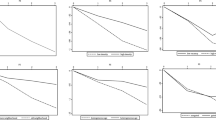Abstract
A general analytical model to describe the impact of environmental disamenities on duration of sales is derived. A statistical technique to recover a seller’s reservation price is proposed. An econometric procedure that consistently estimates market duration and a seller’s reservation price is described. An application to the impact of highway noise on property values and market duration is presented. The estimation results show that, while highway noise has a significant negative impact on forming reservation prices and predicting sale prices, the noise effect on duration of sales is not statistically significant. Empirical evidence also shows a negative impact of market duration on reservation prices, which indicates an updating process for reservation prices over time.
Similar content being viewed by others
References
Aigner, D. J., C. A. Knox Lovell, and P. Schmidt. (1977). “Formulation and Estimation of Stochastic Frontier Production Function Models,” Journal of Econometrics 5, 21–38.
Allison, P. D. (1995). Survival Analysis Using the SAS System: A Practical Guide. Cary, NC: SAS Institute.
Asabere, P. K., and F. E. Huffman. (1993). “Price Concessions, Time on the Market, and the Actual Sale Price of Homes,” Journal of Real Estate Finance and Economics 6, 167–174.
Bikhchandani, S., and S. Sharma. (1996). “Optimal Search with Learning,” Journal of Economic Dynamics and Control 20, 333–359.
Greene, W. H. (1990). “A Gamma-Distributed Stochastic Frontier Model,” Journal of Econometrics 46, 141–163.
Haurin, D. (1988). “The Duration of Marketing Time of Residential Housing,” AREUEA Journal 16, 396–410.
Hofler, R. A., and K. J. Murphy. (1994). “Estimating Reservation Wages of Employed Workers Using a Stochastic Frontier,” Southern Economic Journal 60, 961–976.
Horowitz, J. L. (1992). “The Role of the List Price in Housing Markets: Theory and an Econometric Model,” Journal of Applied Econometrics 7, 115–129.
Hwang, H., D. T. Mortensen, and W. R. Reed. (1998). “Hedonic Wages and Labor Market Search,” Journal of Labor Economics 16, 815–847.
Kalbfleisch, J. D., and R. L. Prentice. (1980). The Statistical Analysis of Failure Time Data. New York: Wiley.
Kang, H. B., and M. J. Gardner. (1989). “Selling Price and Marketing Time in the Residential Real Estate Market,” Journal of Real Estate Research 4, 21–35.
Kopp, R. J., and J. Mullahy. (1990). “Moment-Based Estimation and Testing of Stochastic Frontier Models,” Journal of Econometrics 46, 165–183.
Lancaster, T. (1985). “Simultaneous Equations Models in Applied Search Theory,” Journal of Econometrics 28, 113–126.
Lippman, S. A., and J. J. McCall. (1976). “The Economics of Job Search: A Survey,” Economic Inquiry 14(2), 155–190.
Miller, N. G. (1978). “Time on the Market and Selling Price,” AREUEA Journal 6, 164–174.
Mortensen, D. T. (1986). “Job Search and Labor Market Analysis.” In O. Ashenfelter and R. Layard (eds.), Handbook of Labor Economics, (vol. 2, pp. 849–919). New York: Elsevier Science.
Nelson, J. P. (1982). “Highway Noise and Property Values, A Survey of Recent Evidence,” Journal of Transport Economics and Policy 16, 109–138.
Palmquist, R. B. (1980a). “Alternative Techniques for Developing Real Estate Price Indexes,” Review of Economics and Statistics 62(3), 442–448.
Palmquist, R. B. (1980b). Impact of Highway Improvements on Property Values in Washington. Technical report WA-RD-37.1, Washington State Transportation Commission, Department of Transportation, WA, USA.
Palmquist, R. B. (1992). “Valuing Localized Externalities,” Journal of Urban Economics 31, 59–68.
Polachek, S. W., and B. J. Yoon. (1987). “ATwo-Tiered Earnings Frontier Estimation of Employer and Employee Information in the Labor Market,” Review of Economics and Statistics 69, 296–302.
Ridker, R. G., and J. A. Henning. (1967). “The Determinants of Residential Property Values with Special Reference to Air Pollution,” Review of Economics and Statistics 49, 246–257.
Robbins, H. (1970). “Optimal Stopping,” American Mathematical Monthly 77, 333–343.
Rosenfield, D. B., and R. D. Shapiro. (1981). “Optimal Adaptive Search,” Journal of Economic Theory 25, 1–20.
Rothschild, M. (1974). “Searching for the Lowest Price When the Distribution of Prices Is Unknown,” Journal of Political Economy 82, 689–711.
Schmidt, P. (1986). “Frontier Production Functions,” Econometric Reviews 4, 289–328.
Smith, V. K., and J.-C. Huang. (1995). “Can Markets Value Air Quality? A Meta-Analysis of Hedonic Property Value Methods,” Journal of Political Economy 103, 209–227.
Stevenson, R. E. (1980). “Likelihood Functions for Generalized Stochastic Frontier Estimation,” Journal of Econometrics 13, 57–66.
Author information
Authors and Affiliations
Rights and permissions
About this article
Cite this article
Huang, JC., Palmquist, R.B. Environmental Conditions, Reservation Prices, and Time on the Market for Housing. The Journal of Real Estate Finance and Economics 22, 203–219 (2001). https://doi.org/10.1023/A:1007891430162
Issue Date:
DOI: https://doi.org/10.1023/A:1007891430162




